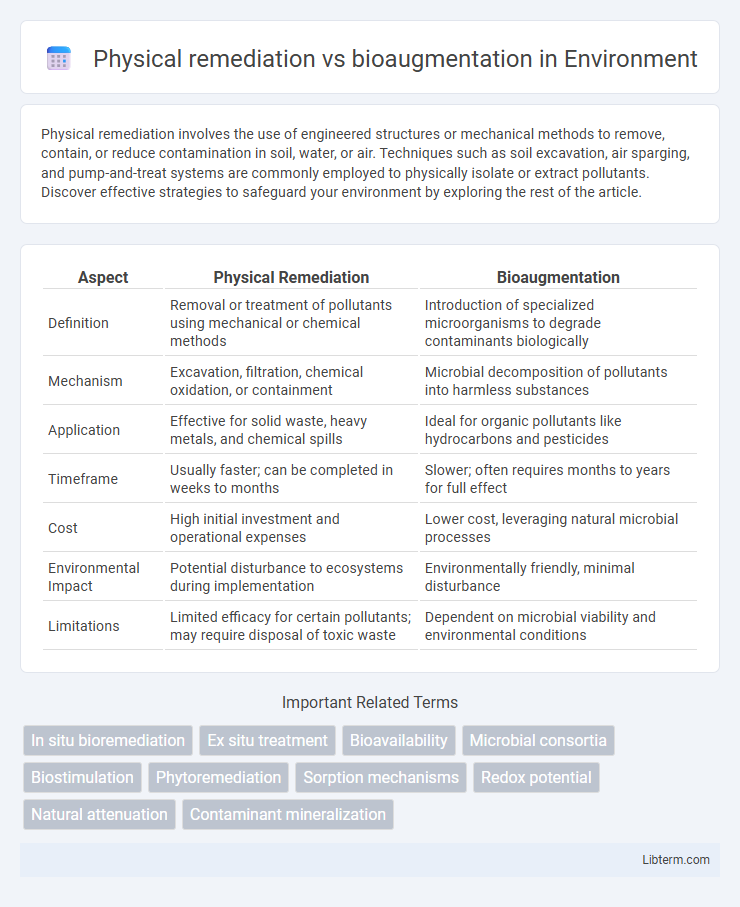Physical remediation involves the use of engineered structures or mechanical methods to remove, contain, or reduce contamination in soil, water, or air. Techniques such as soil excavation, air sparging, and pump-and-treat systems are commonly employed to physically isolate or extract pollutants. Discover effective strategies to safeguard your environment by exploring the rest of the article.
Table of Comparison
| Aspect | Physical Remediation | Bioaugmentation |
|---|---|---|
| Definition | Removal or treatment of pollutants using mechanical or chemical methods | Introduction of specialized microorganisms to degrade contaminants biologically |
| Mechanism | Excavation, filtration, chemical oxidation, or containment | Microbial decomposition of pollutants into harmless substances |
| Application | Effective for solid waste, heavy metals, and chemical spills | Ideal for organic pollutants like hydrocarbons and pesticides |
| Timeframe | Usually faster; can be completed in weeks to months | Slower; often requires months to years for full effect |
| Cost | High initial investment and operational expenses | Lower cost, leveraging natural microbial processes |
| Environmental Impact | Potential disturbance to ecosystems during implementation | Environmentally friendly, minimal disturbance |
| Limitations | Limited efficacy for certain pollutants; may require disposal of toxic waste | Dependent on microbial viability and environmental conditions |
Understanding Physical Remediation: Principles and Techniques
Physical remediation involves techniques such as soil excavation, air sparging, and thermal treatment to remove or contain contaminants in the environment. These methods rely on mechanical and physical processes to directly extract or neutralize pollutants without altering biological activity. Understanding the principles of physical remediation is crucial for selecting appropriate techniques based on contaminant type, site conditions, and cleanup goals.
What is Bioaugmentation? A Scientific Overview
Bioaugmentation is a bioremediation technique that involves the introduction of specific strains of microorganisms to contaminated environments to enhance the degradation of pollutants, particularly hydrocarbons and heavy metals. This method contrasts with physical remediation, which relies on mechanical removal or containment of contaminants without altering microbial populations. Bioaugmentation leverages the metabolic capabilities of specialized bacteria, fungi, or archaea to accelerate the natural breakdown of toxic substances in soil and water ecosystems.
Key Differences: Physical Remediation vs. Bioaugmentation
Physical remediation relies on mechanical or chemical methods to remove or neutralize contaminants from soil, water, or air, often involving excavation, soil washing, or thermal treatments. Bioaugmentation enhances the natural microbial community by introducing specialized microorganisms or enzymes to accelerate the biodegradation of pollutants. The key difference lies in physical remediation's immediate contaminant removal through external means versus bioaugmentation's biological process that improves contaminant breakdown over time.
Common Applications in Environmental Cleanup
Physical remediation techniques, such as soil excavation and sediment dredging, are commonly applied in sites contaminated with heavy metals and petroleum hydrocarbons to swiftly remove pollutants and reduce environmental hazards. Bioaugmentation involves introducing specific microbial strains to contaminated environments, making it effective for degrading organic pollutants like chlorinated solvents and polycyclic aromatic hydrocarbons in groundwater and soil. Both methods are frequently utilized in industrial spill sites, landfill areas, and wastewater treatment facilities to restore environmental quality and ensure regulatory compliance.
Advantages of Physical Remediation Methods
Physical remediation methods offer rapid contaminant removal by directly extracting pollutants from soil or water, providing immediate site recovery. These techniques, such as soil excavation, soil vapor extraction, and air sparging, are effective for removing metals, hydrocarbons, and volatile organic compounds with minimal impact on microbial ecosystems. Their adaptability to various site conditions and contaminants allows for precise control and monitoring, reducing long-term environmental risks.
Benefits of Bioaugmentation in Soil and Water Treatment
Bioaugmentation enhances soil and water treatment by introducing specialized microorganisms that degrade contaminants more efficiently than physical remediation methods, accelerating pollutant breakdown and restoring ecosystems. This biological approach improves the bioavailability of pollutants, reduces treatment time, and supports sustainable environmental recovery without extensive mechanical disruption. Enhanced microbial diversity from bioaugmentation promotes long-term contaminant attenuation and improved soil and water quality.
Limitations and Challenges: Physical Remediation
Physical remediation faces significant limitations including high operational costs, extensive labor requirements, and disruption to the site environment. It often struggles with incomplete contaminant removal and the potential for secondary waste generation, complicating disposal processes. Additionally, physical methods may be ineffective for deeply embedded or widespread contaminants, limiting their applicability in complex subsurface conditions.
Bioaugmentation Limitations and Considerations
Bioaugmentation involves introducing specific microorganisms to accelerate contaminant degradation but faces limitations such as potential microbial competition, survival challenges in harsh environmental conditions, and the need for precise compatibility with native microbial communities. Effective bioaugmentation requires thorough site characterization and monitoring to ensure introduced microbes establish and remain active, avoiding unintended ecological impacts. Considerations include the scalability of microbial cultures, regulatory approvals, and the potential for incomplete contaminant breakdown, which may necessitate combining bioaugmentation with other remediation strategies.
Real-World Case Studies: Comparative Outcomes
Physical remediation methods such as soil excavation and pump-and-treat have demonstrated rapid contaminant removal in highly polluted industrial sites, evidenced by the cleanup of the Tar Creek Superfund in Oklahoma. Bioaugmentation, involving the introduction of specialized microorganisms, showed enhanced degradation of persistent organic pollutants in field trials at the TCE-contaminated groundwater site in Dover, Delaware. Comparative studies indicate that while physical methods offer immediate contaminant reduction, bioaugmentation provides sustainable long-term remediation with improved microbial ecosystem restoration.
Choosing the Right Approach: Factors for Decision-Making
Selecting between physical remediation and bioaugmentation depends on site-specific contamination levels, soil properties, and ecological impact. Physical remediation offers rapid contaminant removal for heavily polluted sites, while bioaugmentation enhances microbial activity to degrade pollutants naturally, suitable for biodegradable contaminants. Cost-effectiveness, timeline, and long-term sustainability are critical factors influencing the decision-making process.
Physical remediation Infographic

 libterm.com
libterm.com